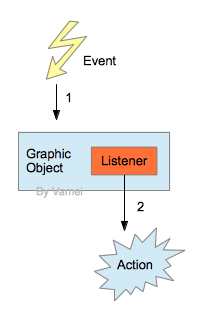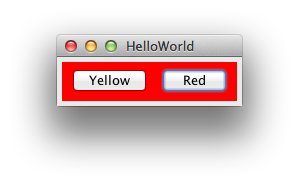在GUI中,我们看到了如何用图形树来组织一个图形界面。然而,这样的图形界面是静态的。我们无法互动的对该界面进行操作。GUI的图形元素需要增加事件响应(event handling),才能得到一个动态的图形化界面。
元素, 事件, 监听器
我们在GUI一文中提到了许多图形元素。有一些事件(Event)可能发生在这些图形元素上,比如:
点击按钮
拖动滚动条
选择菜单
Java中的事件使用对象表示,比如ActionEvent。每个事件有作用的图形对象,比如按钮,滚动条,菜单。
所谓互动的GUI,是指当上面事件发生时,会有相应的动作产生,比如:
改变颜色
改变窗口内容
弹出菜单
每个动作都针对一个事件。我们将动作放在一个监听器(ActionListener)中,然后让监听器监视(某个图形对象)的事件。当事件发生时,监听器中的动作随之发生。

因此,一个响应式的GUI是图形对象、事件对象、监听对象三者互动的结果。我们已经知道了如何创建图形对象。我们需要给图形对象增加监听器,并让监听器捕捉事件。
按钮响应
下面实现一个响应式的按钮。在点击按钮之后,面板的颜色会改变,如下图:

(这个例子改编自Core Java 2,Volume 1, Example 8-1)
import javax.swing.*;
import java.awt.event.*;
import java.awt.*;
public class HelloWorldSwing {
private static void createAndShowGUI() {
JFrame frame = new JFrame("HelloWorld");
frame.setDefaultCloseOperation(JFrame.EXIT_ON_CLOSE);
// Pane's layout
Container cp = frame.getContentPane();
cp.setLayout(new FlowLayout());
// add interactive panel to Content Pane
cp.add(new ButtonPanel());
// show the window
frame.pack();
frame.setVisible(true);
}
public static void main(String[] args) {
Runnable tr = new Runnable() {
public void run() {
createAndShowGUI();
}
};
javax.swing.SwingUtilities.invokeLater(tr);
}
}
/**
* JPanel with Event Handling
*/
class ButtonPanel extends JPanel
{
public ButtonPanel()
{
JButton yellowButton = new JButton("Yellow");
JButton redButton = new JButton("Red");
this.add(yellowButton);
this.add(redButton);
/**
* register ActionListeners
*/
ColorAction yellowAction = new ColorAction(Color.yellow);
ColorAction redAction = new ColorAction(Color.red);
yellowButton.addActionListener(yellowAction);
redButton.addActionListener(redAction);
}
/**
* ActionListener as an inner class
*/
private class ColorAction implements ActionListener
{
public ColorAction(Color c)
{
backgroundColor = c;
}
/**
* Actions
*/
public void actionPerformed(ActionEvent event)
{
setBackground(backgroundColor); // outer object, JPanel method
repaint();
}
private Color backgroundColor;
}
}上面,我们用一个内部类ColorAction来实施ActionListener接口。这样做是为了让监听器能更方便的调用图形对象的成员,比如setBackground()方法。
ActionListener的actionPerformed()方法必须被覆盖。该方法包含了事件的对应动作。该方法的参数为事件对象,即监听ActionEvent类型的事件。ActionEvent是一个高层的类,Java会找到图形对象(按钮)会发生的典型事件(点击)作为事件。
ColorAction生成的对象即为监听器对象。
我们为两个按钮JButton添加了相应的监听器对象。当有事件发生时,对应动作将随之产生。


 随时随地看视频
随时随地看视频



